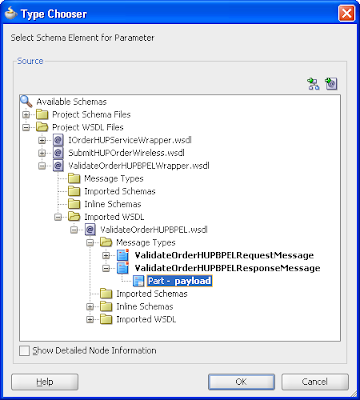To add additional source, right-click the source panel to display the context menu.
Select Add Source and enter a parameter name for the source (the name can also be qualified by a namespace and prefix) in the Add Source dialog.
Select or import the appropriate schema or WSDL file for the parameter in the same manner as when creating a new XSLT map. For this example, the response of validateOrderHup from the WSDL is selected.
Change to the source view and you can see the follow high-lighted code was added.
Source type - can be XSD or WSDL
Schema details - location, root element name and namespace
Parameter name - follow naming convention VARIABLE_NAME.VARIABLE_PART_NAME .
The additional sources are defined as global parameters and have schema files defining their structure. The follow line will be added to the XSLT map file.
<xsl:param name="validateOrderHUP_OnMessage_processResponse_InputVariable.payload"/>
NOTE: The XSL has no knowledge of BPEL variables. When you add an additional sources in XSL design time, ensure you also add the additional source in the transform activity of a BPEL process. (Otherwise, you will get an error message )
This can be done by adding the variable using the green plus symbol in the transform activity or you can manually change it based on the follow format.
Format: ora:doXSLTransformForDoc('url_to_xslt',input,['paramQname',paramValue]*)
input - Specifies the input variable name. (occurrence = 1)
paramQname - Specifies the parameter QName. (occurrence >= 1 )
paramValue - Specifies the value of the parameter. (occurrence >= 1 , same as paramQname )
ora:doXSLTransformForDoc("xsl/Generate_Request.xsl", $inputVariable.payload, "validateOrderHUP_OnMessage_processResponse_InputVariable.payload", $validateOrderHUP_OnMessage_processResponse_InputVariable.payload)
If we manually to add the above things, we need to handle the schema namespace properly and add them to the list of referred namespaces in the stylesheet tag using xmlns tag.




No comments:
Post a Comment